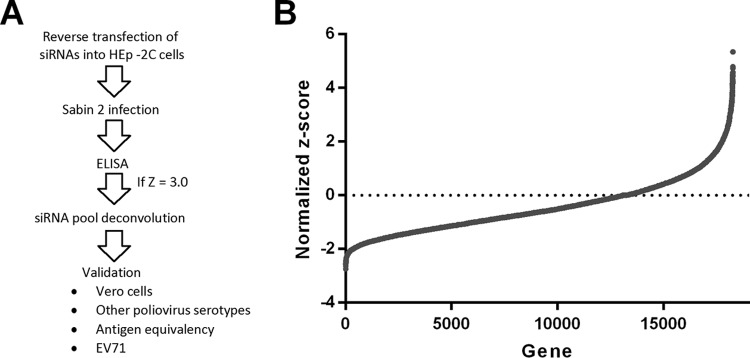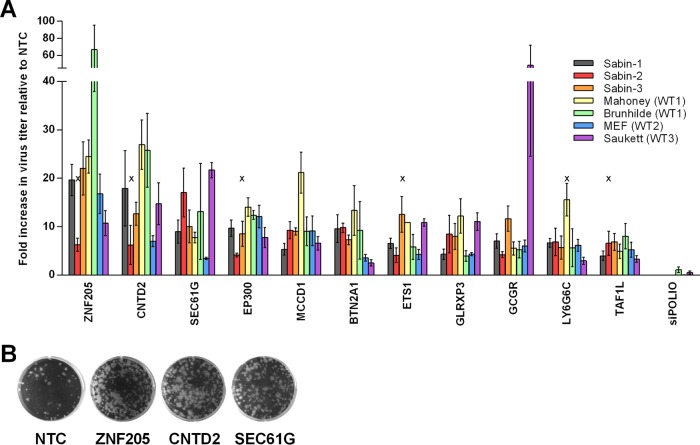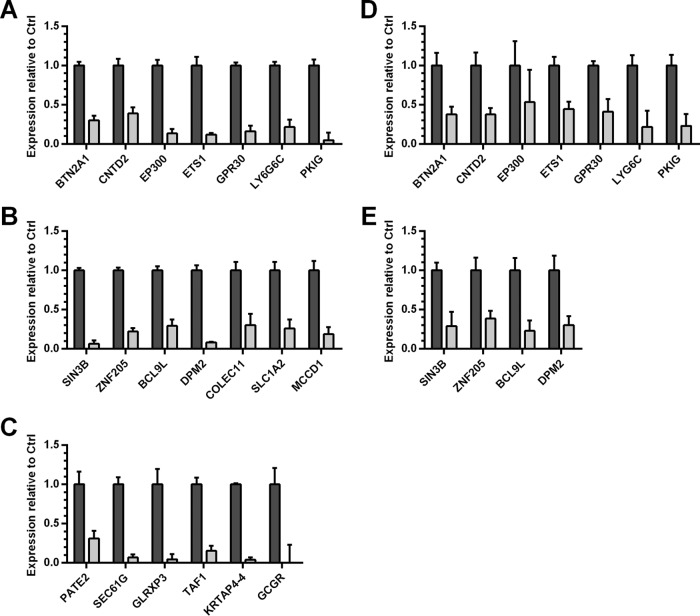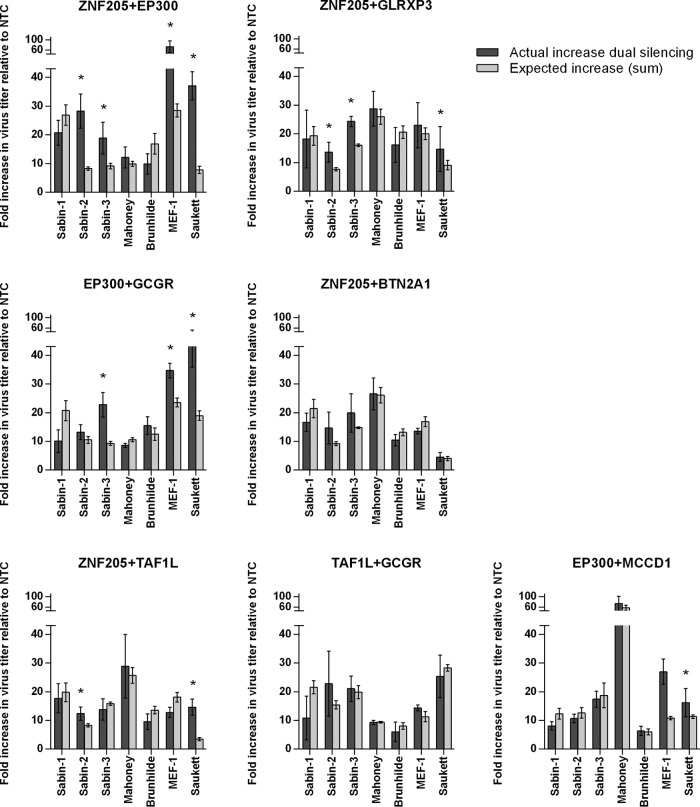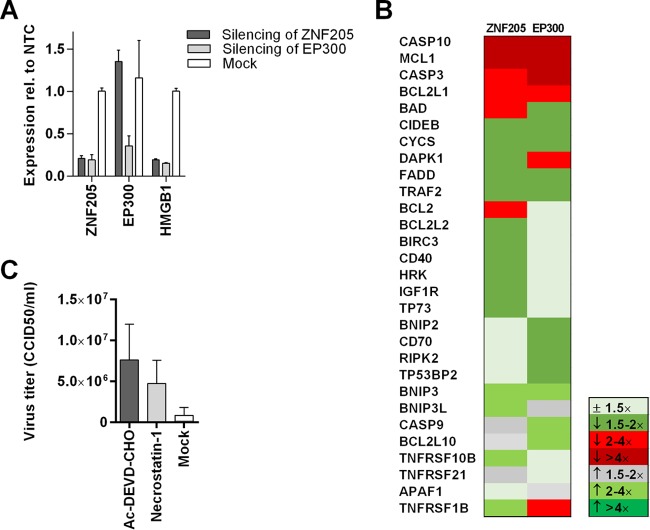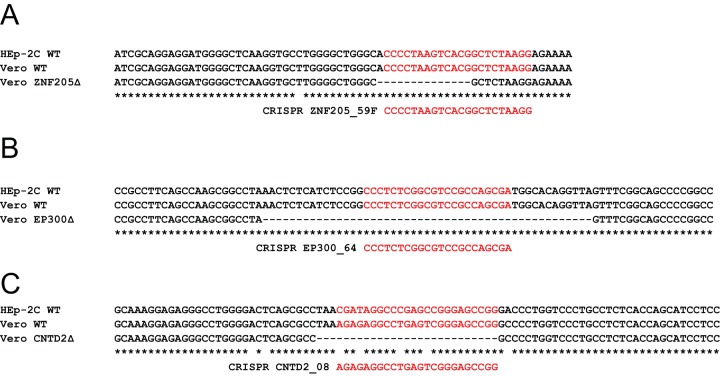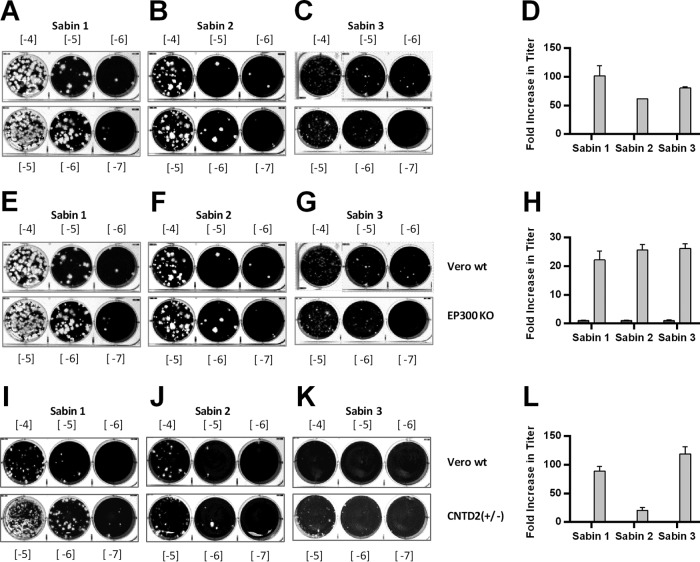ABSTRACT
Vaccine manufacturing costs prevent a significant portion of the world's population from accessing protection from vaccine-preventable diseases. To enhance vaccine production at reduced costs, a genome-wide RNA interference (RNAi) screen was performed to identify gene knockdown events that enhanced poliovirus replication. Primary screen hits were validated in a Vero vaccine manufacturing cell line using attenuated and wild-type poliovirus strains. Multiple single and dual gene silencing events increased poliovirus titers >20-fold and >50-fold, respectively. Host gene knockdown events did not affect virus antigenicity, and clustered regularly interspaced short palindromic repeat (CRISPR)-Cas9-mediated knockout of the top candidates dramatically improved viral vaccine strain production. Interestingly, silencing of several genes that enhanced poliovirus replication also enhanced replication of enterovirus 71, a clinically relevant virus to which vaccines are being targeted. The discovery that host gene modulation can markedly increase virus vaccine production dramatically alters mammalian cell-based vaccine manufacturing possibilities and should facilitate polio eradication using the inactivated poliovirus vaccine.
IMPORTANCE Using a genome-wide RNAi screen, a collection of host virus resistance genes was identified that, upon silencing, increased poliovirus and enterovirus 71 production by from 10-fold to >50-fold in a Vero vaccine manufacturing cell line. This report provides novel insights into enterovirus-host interactions and describes an approach to developing the next generation of vaccine manufacturing through engineered vaccine cell lines. The results show that specific gene silencing and knockout events can enhance viral titers of both attenuated (Sabin strain) and wild-type polioviruses, a finding that should greatly facilitate global implementation of inactivated polio vaccine as well as further reduce costs for live-attenuated oral polio vaccines. This work describes a platform-enabling technology applicable to most vaccine-preventable diseases.
INTRODUCTION
Vaccines are important defenses in the fight against infectious disease. Currently, a complex set of factors such as population dynamics and bioproduction costs limit the ability to provide adequate immunization coverage to many economically distressed countries. The current efforts to eradicate poliovirus exemplify these challenges. The oral polio vaccine (OPV), consisting of attenuated Sabin strains, has reduced the total number of poliomyelitis cases by >99% since the late 1980s. However, live attenuated strains carry the risk of phenotypic reversion to a neurovirulent “vaccine-derived poliovirus” (VDPV) capable of inducing vaccine-associated paralytic poliomyelitis (VAPP) (1, 2). To prevent the emergence and circulation of VDPVs during the polio eradication effort and beyond, OPV must be replaced by the inactivated poliovirus vaccine (IPV) (3). The cost of IPV, which is approximately $3.00 per dose compared to approximately $0.20 for OPV, is a major obstacle to its widespread application. Further, to achieve effective protection using IPV requires multiple vaccinations. Thus, a successful transition to the use of IPV requires new technologies that will increase vaccine production at greatly reduced costs.
Vaccines are also needed to address other non-poliovirus-related public health issues, including those presented by enterovirus 71 (EV71). Since 1997, EV71 has caused numerous large outbreaks of hand, foot, and mouth disease (HFMD) in the Asia-Pacific region, often accompanied by severe neurologic disease (4–6). Currently, multiple EV71 vaccine clinical trials are ongoing (7), and, as in the case of poliovirus, new technologies that increase vaccine production at reduced costs are needed to facilitate introduction of these novel vaccines.
Mammalian cell lines are used for most vaccine production processes. For example, the Vero cell line derived from African green monkey kidney cells is used in polio vaccine production (8). As viruses have a limited genome, they usurp host cell functions to produce progeny virus. Given this, studies that identify host genes that facilitate and restrict virus replication can be used to create a new generation of stable, high-performance vaccine manufacturing cell lines. Such platform-enabling technologies would facilitate poliovirus eradication efforts and enhance attempts to eradicate a range of other vaccine-preventable diseases.
To create enhanced poliovirus vaccine cell lines, the poliovirus resistance genes in a Vero vaccine cell line were identified using a genome-wide RNA interference (RNAi) screen. Validation of the hits demonstrated that modulating expression of host genes individually or in combination dramatically increased poliovirus replication by 10-fold to >50-fold without altering poliovirus antigenicity. Moreover, cell lines containing clustered regularly interspaced short palindromic repeat (CRISPR)-Cas9-mediated knockouts (KOs) of the validated host genes performed as well as or better than cell lines treated with small interfering RNAs (siRNAs). Importantly, silencing or knockout of several of these genes also enhanced EV71 replication. These findings show that engineering current vaccine manufacturing platforms is a viable strategy for addressing global vaccine needs.
MATERIALS AND METHODS
Cells and viruses.
The primary RNAi screen was performed using human epidermoid carcinoma (HEp-2C) cells (ATCC CCL-23). Primary screen hits were validated in a Vero (African green monkey kidney) cell line licensed for poliovirus vaccine production. Both HEp-2C and Vero cells were cultured at 37°C and 5% CO2 in Dulbecco's modified Eagle's medium (DMEM; HyClone, GE Healthcare) supplemented with 10% fetal bovine serum (FBS; HyClone). The same passage numbers of HEp-2C and Vero cells were used during the screening and in validation studies to minimize differences and aid interpretation. For both cell lines, a master cell bank was created to ensure that all experiments were performed using a consistent low number of cell passages.
A single lot of the attenuated Sabin type 2 (Sabin-2) vaccine (National Institute for Biological Standards and Control [NIBSC], Health Protection Agency, Potters Bar, United Kingdom) was used for the primary screen. Validation experiments in Vero cells were performed with NIBSC Sabin strains of serotypes 1, 2, and 3 and with the wild-type poliovirus IPV seed strains Mahoney (serotype 1), Brunhilde (serotype 1, used by one manufacturer), MEF-1 (serotype 2), and Saukett (serotype 3). Validation experiments for EV71 were performed with an EV71 sub-genogroup C2 strain isolated in Taiwan in 1998 (9).
Human siRNA library.
The ON-TARGETplus small interfering RNA (OTP-siRNA) library (GE Healthcare, Lafayette, CO) was used to target >18,200 protein-encoding host genes in HEp-2C cells in the primary screen. Pools of four siRNAs targeting different regions in the same gene were used for the primary screen. To eliminate false positives, validation of primary screen hits began by testing each of the siRNAs in the original pool individually (“deconvolution”) to assess whether multiple individual siRNAs targeting the same gene gave rise to the same increase-in-titer phenotype. These studies were complemented with additional siRNAs targeting the same gene but derived from a separate RNAi library (siGenome; GE Healthcare). Targets were considered legitimate when the results could be reproduced with two or more individual siRNAs (10). All siRNAs that led to a cell death phenotype, i.e., cytotoxicity, were identified using a ToxiLight bioassay (Lonza, Walkersville, MD) according to the manufacturer's instructions, and these genes were excluded from further analysis. The effect of gene silencing on cell proliferation was studied using a CellTiter 96 nonradioactive cell proliferation assay kit (Promega Inc., Fitchburg, WI), according to the manufacturer's instructions. Individual siRNAs correlating with the highest increase in virus antigen content were used for validation of hit genes in Vero cells. For all experiments subsequent to the primary screen and deconvolution studies, individual siRNAs targeting each gene were employed.
Primary siRNA screen and validation.
For the genome-wide screen, siRNAs in 96-well plate format were reverse transfected in triplicate into HEp-2C cells at a final concentration of 50 nM using 0.3% DharmaFECT 4 transfection reagent (GE Healthcare). Briefly, On-TARGETplus siRNAs were mixed with DharmaFECT 4 reagent in serum-free medium (Opti-MEM; Invitrogen Inc., Carlsbad, CA) and incubated at room temperature for 20 min. A nontargeting control siRNA (siNTC; GE Healthcare) and a poliovirus type-specific siRNA targeting the poliovirus capsid-encoding region (siPOLIO [11]) were included as controls. HEp-2C cells were subsequently added (9,000 cells/well) with DMEM supplemented with 10% FBS. Transfected cells were cultured at 37°C and 5% CO2. After 48 h, the medium was removed and cells were infected with Sabin-2 (multiplicity of infection [MOI] = 0.05) and 150 μl of DMEM supplemented with 2% FCS and 1% penicillin-streptomycin. Twenty-four hours postinfection (hpi), the plates were frozen at −80°C and stored until analysis of antigen content by enzyme-linked immunosorbent assay (ELISA).
For validation of the gene hits identified in the primary screen, individual siRNAs were reverse transfected into Vero cells as described above using 7,500 cells per well. Dual gene silencing experiments were performed at a final siRNA concentration of 50 nM (25 nM each siRNA) using cells transfected with individual siRNAs at a concentration of 25 nM as reference. Cells were infected with Sabin-1, -2, or -3 viruses, wild-type polioviruses, or EV71 at an MOI optimized for each individual virus stock to enable detection of significant differences in the amounts of infectious virus produced in modified versus unmodified cells on the same 96-well plate at 21 to 26 h postinfection. Infected cells were incubated at 37°C and 5% CO2 and subsequently frozen at −80°C. In addition, cell viability was measured for the top hits using a CellTiter 96 nonradioactive cell proliferation assay kit (Promega), as described above, according to the manufacturer's instructions.
Poliovirus ELISA.
To screen for host genes involved in Sabin-2 virus replication, a screen was performed using a poliovirus type 2-specific ELISA. Briefly, 50 μl of each cell supernatant in 96-well plates was transferred to Immulon 2 HB high-binding-affinity 96-well plates (Thermo Fisher) coated with a poliovirus type 2-specific monoclonal antibody (HYB294-06, mouse; Pierce Antibodies, Thermo Scientific) and incubated at 37°C for 60 min. The plates were washed 4× with PBST buffer (phosphate-buffered saline with 0.25% Tween 20). Following the final wash, the plates were incubated with an optimal concentration of poliovirus type 2-specific monoclonal antibody (HYB294-06) conjugated to horseradish peroxidase (HRP) and incubated at 37°C for 60 min and were washed 1× with PBST buffer, followed by a 15-min incubation with HRP-substrate solution (SureBlue TMB; KPL Inc., Gaithersburg, MD). The reaction was stopped by addition of 50 μl of TMB BlueSTOP solution (KPL). Optical density (OD) values were read at a wavelength of 620 nm using a plate spectrophotometer (Tecan Sapphire 2; Männedorf, Switzerland). The ELISA data were normalized by subtracting background intensity values from the raw data points and converted to a Z-score for scoring positive hits as described previously (12). Hits with a Z-score of ≥3.0 were subjected to further validation in HEp-2c and Vero cells.
Quantification of infectious virus by CCID50 and plaque assay.
Hits from the primary screen were validated in Vero cells in part by determining the virus titers, expressed as 50% cell culture infective dose (CCID50) values, using endpoint dilution (13). Briefly, using a 96-well format, 10-fold serial dilutions of the virus supernatant (starting with a 10−2 dilution and diluting up to 10−9) were incubated with HEp-2C cells (7,500 cells/well in minimal essential medium [MEM] supplemented with 2% FBS) using 11 replicates per dilution at 37°C and 5% CO2 for 5 days. The CCID50 was calculated by scoring cytopathic effect (CPE) in all wells and subjecting the findings to analysis by the Spearman-Kärber method (13). Titers of EV71 were determined following the same procedure (in triplicate) as described above but using human rhabdomyosarcoma (RD) cells (ATCC CCL-136). For viral plaque assays, monolayers of HEp-2C cells (or RD cells for EV71) were cultured to >95% confluence in a 6-well plate and incubated with 200 μl of 10-fold serial dilutions of virus supernatant at 37°C and 5% CO2 for 1 h. Cells were subsequently overlaid with 0.9% agarose (SeaPlaque agarose; Lonza) mixed with 2× concentrated MEM supplemented with 4% FBS (1:1 ratio). Plates were incubated at 37°C and 5% CO2 for 48 h. Plaques were visualized by removing the agarose and staining cells with crystal violet-containing formalin. All experiments were performed in triplicate. For quantification of infectious poliovirus Sabin-1, Sabin-2, and Sabin-3 produced in stable KO cell lines, the parental Vero, Vero-ΔZNF205, Vero-ΔEP300, or Vero-ΔCNTD2 cells were plated in 96-well cell culture plates and infected with Sabin-1, Sabin-2, and Sabin-3. The virus-infected plates were incubated for 48 h before harvesting for titration of virus titer using a plaque assay performed as described above. All experiments were performed in triplicate.
RNA isolation and real-time PCR.
The expression levels of host genes were evaluated by real-time reverse transcription (RT)-PCR using predesigned gene-specific probes and primers (Solaris expression assay; GE Healthcare) and an apoptotic RT2 Profiler PCR array (Qiagen, Germantown, MD) according to the manufacturers' instructions. Forty-eight hours after siRNA transfection, total RNA was isolated from mock-infected and transfected HEp-2C cells and Vero cells using an RNeasy minikit (Qiagen) according to the manufacturer's protocol. Expression levels of high-mobility group box 1 protein (HMGB1; a marker for necrosis) and genes of the apoptotic pathway were studied in cells infected with Sabin-1 poliovirus (MOI = 1.0) at 3.5 h prior to RNA isolation. In total, 1 μg of RNA was converted to cDNA using a Maxima First Strand cDNA synthesis kit (Thermo Fisher Scientific) or an RT2 First Strand synthesis kit (Qiagen) for samples to be amplified in the Solaris expression assay or the RT2 Profiler PCR array, respectively, according to the manufacturers' protocols. Amplification was performed using an ABI 7500 thermocycler (Life Technologies, Grand Island, NY). Threshold cycle (CT) values were normalized against those of GAPDH (glyceraldehyde-3-phosphate dehydrogenase) in the same sample and used to calculate the mRNA expression levels in siRNA-transfected cells relative to those in cells transfected with the siNTC, using the ΔΔCT method (14).
Small-molecule inhibitors.
Features linked to programmed cell death were evaluated by determining the CCID50 titer of Sabin-1 poliovirus in Vero cells cultured in the presence of inhibitors of the necrotic and apoptotic pathways (necrostatin-1 and Ac-DEVD-CHO, respectively). Briefly, in 96-well plates, Vero cells (1 × 104 cells/well) were cultured in the presence of 125-fold serial dilutions (final concentration of 33 μM to 0.07 nM) of necrostatin-1 (Sigma-Aldrich, St. Louis, MO) or Ac-DEVD-CHO (Biotium, Hayward, CA) with DMEM supplemented with 10% FBS at 37°C and 5% CO2 for 24 h. Cells cultured in the absence of small-molecule inhibitors were included as a reference. After 24 h, cells were infected with Sabin-1 poliovirus (MOI = 1.0) with DMEM supplemented with 2% FBS and were incubated at 37°C and 5% CO2 for ∼26 h. Cells were frozen at −80°C, and virus titers were determined relative to those from cells cultured in the absence of inhibiting drugs by means of endpoint dilution (CCID50) as described above. All experiments were performed in quadruplicate.
Antigen equivalency testing.
Viruses from siRNA-transfected Vero cells were tested for reactivity with a standard pool of human sera collected from individuals previously exposed to poliovirus vaccine or a rabbit polyclonal anti-EV71 serum (kindly provided by H. Shimizu, National Institute of Infectious Diseases, Japan). In a 96-well format, 100 CCID50 of virus supernatant derived from control and gene knockdown (KD) wells was incubated with 2-fold serial dilutions of serum (1:8 to 1:1,024) with MEM supplemented with 2% FBS at 37°C and 5% CO2 for 3 h. HEp-2C cells or RD cells (for EV71) (7,500 cells/well, in MEM supplemented with 2% FBS) were added and the plates incubated at 37°C and 5% CO2 for 5 days. The neutralizing titer was calculated on the basis of the number of wells showing CPE using the Spearman-Kärber method (13).
Knockout of target genes with CRISPR technology.
CRISPR gene editing technology was used to generate KO Vero cell lines at the ZNF205, EP300, and CNTD2 loci. Guide-strand RNAs targeting each gene (for ZNF205, CCCCTAAGTCACGGCTCTAAGG; for EP300, CCCTCTCGGCGTCCGCCAGCGA; and for CNTD2, CCGGCTCCCGGCTCGGGCCTAT) were transfected into Vero cells together with a CRISPR-Cas9 expression construct per the manufacturer's instructions (Sigma-Aldrich). Genomic DNA was isolated from individual colonies (Gentra Puregene; Qiagen), and the status of the target site was assessed by Sanger sequencing on an ABI 3130xl genetic analyzer. The primer sets used for sequence analysis were as follows: for ZNF205, ZNF5961F (AGCTGTGTCTTGCATGTTGG) and ZNF5961R (GTCTCTGGTCCTCCCTCTC); for EP300, EP3002F (CGAGGAGGAAGAGGTTGATG) and EP3002R (ACGTCTTCGACCAGCTCATT); and for CNTD2, CNTD2F (GCATCTCCAGCGCTTAAAAC) and CNTD2R (CAGGATGAGGCTCTGTCTCC). Cell viability studies were performed on parental Vero cells as well as on Vero KO cell lines using a CellTiter 96 nonradioactive cell proliferation assay kit (Promega Inc.), as described above.
Ingenuity Pathway Analysis.
The host cell pathways associated with validated genes were identified using Ingenuity Pathway Analysis (Qiagen, Redwood City, CA), and the Ingenuity knowledge base (genes only) was used as a reference set for estimating the probability that genes and pathways were associated by chance alone.
Statistical analysis.
To identify gene hits, virus titration data were analyzed using the SAS software package, version 9.2 (SAS Institute, Cary, NC). Titers from gene silencing events were analyzed relative to the titers determined in experiments that incorporated NTCs, and, in cases of dual silencing, the sum of the titers of the individual silencing events on the same 96-well plate was evaluated using a nonparametric Wilcoxon two-sample exact test. Titers were considered to be significantly higher than those in the controls when P was <0.05.
RESULTS
Primary RNAi screen in HEp-2C cells.
A genome-wide small interfering RNA (siRNA) screen was performed with HEp-2C cells to identify host gene silencing events that enhanced Sabin-2 poliovirus replication (Fig. 1A) (12, 15). Of the >18,200 protein-encoding genes screened using a poliovirus type 2-specific ELISA, 124 gene silencing events significantly (Z-score ≥ 3) increased Sabin-2 antigen levels compared to nontargeting control results (Fig. 1B; see also Table S1 in the supplemental material). For 76 (61%) genes, two or more siRNAs targeting different sites on the same gene produced the same phenotype and were designated “true positives” (see the top 27 candidates listed in Table S2). As the increases in poliovirus antigen were not associated with increased cell proliferation (data not shown), the top 27 genes were selected for validation in a Vero cell line currently employed in poliovirus vaccine manufacturing.
FIG 1.
Genome-wide siRNA screen. (A) Schematic of siRNA primary screen workflow in HEp-2c cells. (B) Plot of Z-scores from the primary RNAi screen using ELISA. Hits with a Z-score of ≥3.0 were considered candidates for vaccine cell line engineering. y axis, normalized Z-score; x axis, gene number.
Validation of hits in a Vero vaccine manufacturing cell line.
Genes in a subset shown to increase poliovirus replication in HEp-2C cells were validated in a Vero vaccine manufacturing cell line by determining the virus titer (CCID50) following transfection with specific siRNAs. These studies incorporated all three Sabin strains (Sabin-1, -2, and -3 viruses), as well as the wild-type poliovirus IPV seed strains (type 1, Mahoney and Brunhilde; type 2, MEF-1; type 3, Saukett). Knockdown of 11 (40%) of the 27 genes significantly (P < 0.05) increased poliovirus titers for 6 of 7 viruses examined (Fig. 2). Knockdown of ZNF205 gave the broadest profile, enhancing the titers of all but one strain (Sabin-2) by ≥10-fold, and led to a striking 67-fold increase in the Brunhilde virus titer. CNTD2 knockdown provided a similar profile, enhancing the titers of 5 of the 7 strains by at least 1 log. After validating siRNA-mediated gene knockdown of the top 11 genes in both HEp-2C and Vero cells by quantitative RT-PCR (Fig. 3), we evaluated the effects of gene silencing by the same siRNAs (in Vero cells) on a second picornavirus, EV71. Knockdown of three genes, ZNF205, CNTD2, and MCCD1, increased EV71 titers by ≥10-fold (Fig. 4).
FIG 2.
Enhanced poliovirus replication in Vero cells following silencing of host virus resistance genes. (A) Fold change of Sabin and wild-type (WT) poliovirus titers following silencing of top gene hits in Vero cells. Values were calculated relative to the average titers in cells transfected with the nontargeting control siRNA (NTC) (n = 5). Cells transfected with the poliovirus-targeting siRNA (siPOLIO) were included as controls. Data represent the mean fold increases in three transfection experiments ± standard errors of the means (SEM). Values lacking statistically significant differences are indicated with an “x.” For Sabin-2, ZNF205 P = 0.06, CNTD2 P = 0.07, and TAF1L P = 0.1; for Sabin-3, EP300 P = 0.2 and ETS1 P = 0.1; and for Brunhilde, LY6G6C P = 0.1. (B) Plaque assays for three gene knockdown events (ZNF205, CNTD2, and SEC61G) using 10−4 dilutions of Sabin-1 poliovirus supernatants collected from siRNA-transfected Vero cells.
FIG 3.
Validation of gene silencing in HEp-2C and Vero cells by quantitative PCR (qPCR). siRNAs targeting selected hit genes were transfected into HEp-2C or Vero cells. At 48 h posttransfection, cells were harvested for RNA isolation using a Qiagen RNeasy minikit. Gene-specific qPCR was performed in triplicate, and the results were normalized to GAPDH data, with the mean value of the control (Ctrl) for each gene assigned a value of 1. The values represent the means of the results of triplicate experiments ± SEM. Dark gray bars, mean values for nontargeting control; light gray bars, mean values for siRNA-treated cells. (A to C) HEp-2C cells. (D and E) Vero cells.
FIG 4.
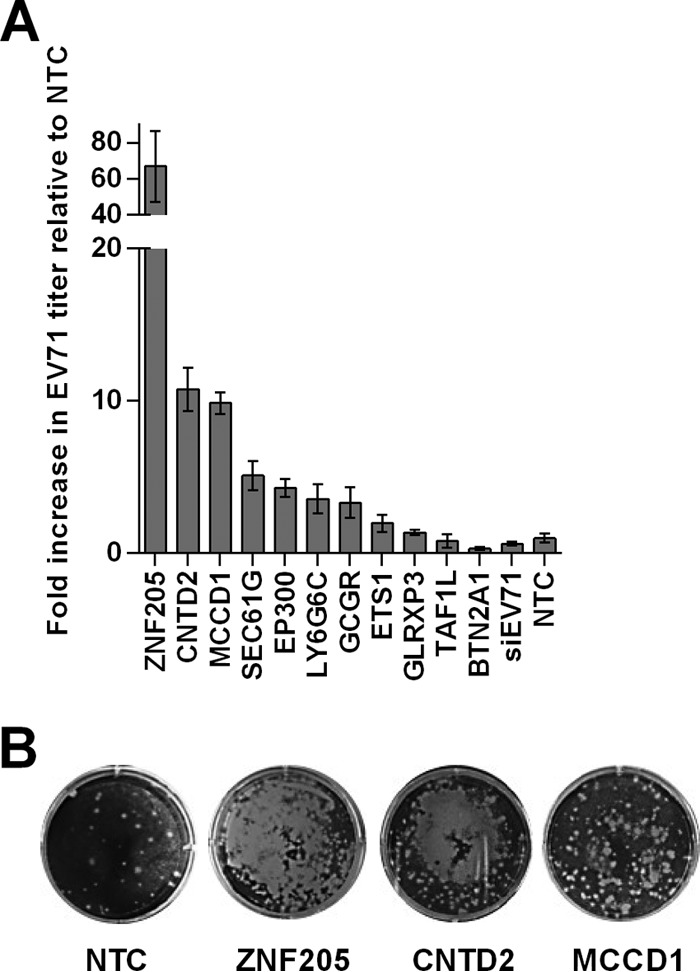
Enhanced EV71 replication following silencing of host virus resistance genes. (A) Fold change of EV71 titers in Vero cells upon silencing of top 11 hits of genes selected from the poliovirus screen. Values were calculated relative to the average titers in cells transfected with the nontargeting control siRNA (NTC) (n = 5). Cells transfected with an EV71-targeting siRNA (siEV71) were included as controls. Data represent the average fold increases in three transfection experiments ± SEM. (B) Plaque assays were performed on 10−5 dilutions of EV71 supernatants collected from siRNA-transfected Vero cells.
Antigen equivalency testing.
To study the effect of host gene silencing on poliovirus and EV71 antigenicity, viruses derived from siRNA-transfected cells were tested in a virus neutralization assay that incorporated human sera collected from individuals previously exposed to poliovirus vaccine or a rabbit polyclonal anti-EV71 serum (kindly provided by H. Shimizu, National Institute for Infectious Diseases, Japan). All polioviruses (Sabin and wild type) and EV71 from modified cells gave neutralizing titers comparable to those produced in unmodified cells, indicating that gene silencing had no effect on virus antigenicity (Table 1).
TABLE 1.
Serum neutralizing titers of Sabin and wild-type polioviruses and EV71 produced in siRNA-transfected Vero cells
| Gene | Virus titer (log2) |
|||||||
|---|---|---|---|---|---|---|---|---|
| Sabin-1 | Sabin-2 | Sabin-3 | Mahoneya | Brunhildea | MEFa | Sauketta | Enterovirus 71b | |
| Control | 6.83 | 7.17 | 6.83 | 8.17 | 6.83 | 7.17 | 7.50 | 4.52 |
| ZNF205 | 7.17 | 7.50 | 6.49 | 8.50 | 8.83 | 9.17 | 8.83 | 4.52 |
| CNTD2 | 7.17 | 8.17 | 7.17 | 8.83 | 9.17 | 8.17 | 9.17 | 4.17 |
| SEC61G | 7.17 | 7.17 | 6.83 | 8.17 | 9.17 | 7.50 | 8.50 | 4.52 |
| EP300 | 6.83 | 6.83 | 7.50 | 9.17 | 8.83 | 9.17 | 9.17 | 4.52 |
| MCCD1 | 6.49 | 7.50 | 7.17 | 9.17 | 9.83 | 9.54 | 8.83 | 4.52 |
| BTN2A1 | 7.17 | 7.50 | 7.17 | 8.83 | 9.17 | 8.83 | 9.50 | N.D. |
| ETS1 | 7.17 | 7.50 | 6.83 | 9.17 | 8.50 | 9.17 | 8.50 | N.D. |
| GLRXP3 | 7.17 | 7.50 | 6.83 | 9.50 | 8.17 | 8.17 | 8.83 | N.D. |
| GCGR | 9.83a | 8.83a | 9.83a | 8.50 | 8.50 | 8.83 | 9.83 | 4.52 |
| LY6G6C | 7.17 | 8.17 | 7.50 | 8.83 | 8.50 | 8.50 | 9.17 | 4.17 |
| TAF1L | 9.83a | 9.17a | 9.83a | 9.17 | 9.17 | 8.83 | 8.83 | N.D. |
Neutralization assays were performed with a different, second pool of in-house human reference sera.
Neutralization assays were performed with a rabbit polyclonal anti-enterovirus 71 serum. N.D., not determined.
Identification of pathways associated with validated host genes.
Ingenuity Pathway Analysis was used to identify the functions, known canonical pathways, and direct/indirect cellular interactions of the top 11 gene targets (Fig. 5; see also Table S3 in the supplemental material). Three genes, EP300, ETS1, and GCGR, are involved in the CREB-dependent transcription pathway and the extracellular signal-regulated kinase 1 (ERK1)/ERK2 (ERK1/2) signaling pathway, with which EP300 and ETS1 have a direct relationship. EP300, as well as GLRXP3 and CNTD2, has also been shown to be related to the NF-κB transcriptional response, regulating cell survival and innate immune responses (16). At least six genes, ETS1, GLRXP3, EP300, GCGR, SEC61g, and ZNF205, are associated with cell death/apoptosis (17–19). Five genes, BTN2A1, SEC61g, ETS1, EP300, and TAF1L, have a direct relationship with ubiquitin C in regulating cell cycle progression, proliferation, and apoptosis.
FIG 5.
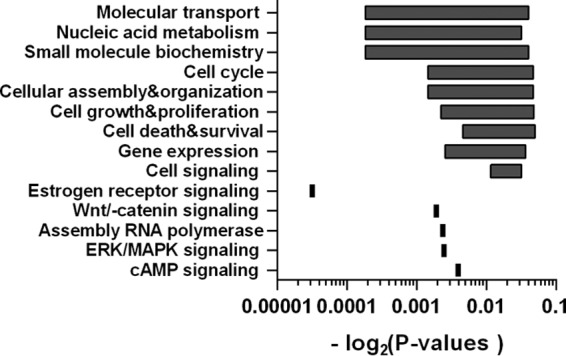
Identification of host molecular functions tied to polio replication. Ingenuity Pathway Analysis was used to identify the functions of the top 11 gene targets. MAPK, mitogen-activated protein kinase; cAMP, cyclic AMP.
Enhancing virus titers by multigene silencing.
The top 11 genes validated in Vero cells were silenced in various combinations to identify gene pairs, preferably in separate pathways, that can be silenced to further enhance poliovirus titers. For 7 of 55 gene combinations examined, the increase in virus titer relative to the nontargeting control (NTC) titer was equal to or higher than that predicted from the sum of the virus titers from the individual genes tested (Fig. 6). Some combinations included genes such as GCGR, TAF1L, and MCCD1 that, when silenced individually, induced ≥10-fold increases in titer for only 1 or 2 of the viruses tested. However, tested in combination, there were >10-fold increases for 5 of 7 viruses tested. Simultaneous silencing of ZNF205 and EP300 resulted in a >10-fold titer increase for 6 of 7 viruses tested, with the observed outcomes exceeding predicted additive effects for 4 of the virus strains. The combination of ZNF205 and GLRXP3 enhanced titers by >10-fold for all 7 viruses tested, with results exceeding additive effects for Sabin-2 and Sabin-3. As was observed for the individual gene silencing events, the increase in virus titers was not a result of increased cell proliferation (data not shown).
FIG 6.
Effects of dual gene silencing on poliovirus replication. Effects of dual gene silencing on Sabin and wild-type strains were assessed. Values were calculated relative to the average titer in cells transfected with the nontargeting control siRNA (NTC) (n = 5). Expected values were calculated on the basis of the sum of fold increases observed in individual silencing events. Values represent the averages of fold increases observed among three transfection experiments. Error bars represent the SEM. Combinations that exceed additive effects on virus titers (P < 0.05) are indicated with a star.
Potential role for EP300 and ZNF205.
Two of the top validated host genes (ZNF205 and EP300) were further investigated to better understand the implications of silencing these genes in vaccine cell lines. As both genes have been previously reported to be associated with cell survival and death/apoptosis (20), the effects of ZNF205 and EP300 silencing on the expression levels of high-mobility group box 1 protein (HMGB1; a marker for necrosis) were assessed. Knockdown of EP300 or ZNF205 reduced expression levels of HMGB1 by 85% or 80%, respectively (Fig. 7A). Knockdown of EP300 also reduced expression of ZNF205 by 81%, but knockdown of ZNF205 did not affect EP300 expression, suggesting an epistatic relationship between the two genes where the phenotype of enhanced virus replication depends on the absence of a modifier gene.
FIG 7.
Effects of ZNF205 and EP300 gene silencing on programmed cell death. (A) Expression levels of HMGB1 (necrosis marker), ZNF205, and EP300 in ZNF205- and EP300-silenced Vero cells infected with Sabin-1 virus. Expression levels were calculated relative to Sabin-1-infected cells transfected with siNTC. Data represent mean values of four transfection experiments ± SEM. (B) Sabin-1 poliovirus titers in Vero cells cultured in the presence of 33 μM Ac-DEVD-CHO or 33 μM necrostatin-1 (inhibitor for the apoptotic pathway or the necrotic pathway, respectively). Data represent the average titers from four experiments; for mock infection experiments, n = 10. Error bars indicate SEM. (C) Fold changes in expression levels of genes of the apoptotic pathway in Sabin-1-infected Vero cells upon ZNF205 and EP300 silencing. Values are expressed relative to expression levels in Sabin-1-infected Vero cells transfected with the siNTC. Data represent average values of four transfection experiments. Only data for genes for which expression was altered by ZNF205 and/or EP300 silencing are presented.
Expression of several genes in the apoptotic pathway was also altered after knockdown of ZNF205 and EP300. For example, expression of caspase-3 and -10 was reduced 83% and 62%, respectively, upon ZNF205 silencing and 85% and 72%, respectively, upon EP300 silencing (Fig. 7B). To explore the relationship between apoptosis and poliovirus replication, Vero cells were infected with poliovirus in the presence of apoptotic and necrosis pathway inhibitors (Ac-DEVD-CHO and necrostatin-1, respectively). At 26 hpi, poliovirus titers in Vero cells treated with Ac-DEVD-CHO and necrostatin-1 were 8.9-fold and 5.5-fold higher than virus titers in untreated cells, suggesting that apoptosis and necrosis suppress poliovirus replication, as might be predicted (Fig. 7C). Importantly, these results suggest that the genes and pathways identified by the primary RNAi screen can be targeted using unrelated technologies, such as the use of small molecules, to modify poliovirus replication.
Effects of gene knockout on poliovirus production.
Three genes, ZNF205, EP300, and CNTD2, were identified as the top candidates for creation of new, high-performance polio vaccine manufacturing cell lines. To knock out ZNF205 function, guide RNA (gRNA) oligonucleotides targeting the ZNF205 gene were introduced along with CRISPR-Cas9 expression constructs into Vero cells. Multiple clones were then isolated, and the ZNF205 locus was sequenced to identify KO cell lines. A Vero knockout clone (Vero-ΔZNF205) containing a 14-nucleotide (nt) deletion in the third exon of the ZNF205 gene (Fig. 8A) was isolated and used for further studies.
FIG 8.
Sequence analysis of ZNF205, EP300, and CNTD2 targets in knockout cell lines. Alignment of ZNF205, EP300, and CNTD2 sequences surrounding the CRISPR-Cas9 target sites in HEp-2C, Vero WT, and Vero KO cell lines is shown.
The parental Vero cell line and Vero-ΔZNF205 cells were infected with Sabin-1, -2, or -3 polioviruses to determine the effects of ZNF205 knockout on poliovirus production. As shown in Fig. 9B and D, the parental cell line generated a titer of 2.05 × 106 PFU of Sabin-2 virus/ml. Under equivalent conditions, four separate Vero-ΔZNF205 clones induced titers ranging from 9 × 107 to 1.9 × 108 PFU/ml (data not shown). Similar improvements in viral titers were observed for Sabin-1 (Fig. 9A and D) and Sabin-3 (Fig. 9C and D). Targeting of the ZNF205 gene in the Vero-ΔZNF205 cell line with ZNF205-siRNA failed to provide further enhancement of viral titers (data not shown), supporting the hypothesis that the genes targeted by knockout and knockdown technologies are the same. These studies support the conclusions that ZNF205 downregulation greatly enhances poliovirus production and that knockout of the ZNF205 gene can increase PV production by 56.7-fold to 88.8-fold over the level seen with the original parental cell line.
FIG 9.
Effects of gene KO on Sabin virus replication. (A to C, E to G, and I to K) Plaque assays showing serial dilutions of viral supernatant derived from unmodified Vero cells and Vero knockout cell lines for ZNF205 (A to C), EP300 (E to G), and CNTD2(+/−) (I to K) clones. Quantitation of plaque titers is depicted in panels D, H, and L. (A to D) Differences in Sabin virus production in unmodified Vero and Vero-ΔZNF205 cells. (E to H) Differences in Sabin virus production in unmodified Vero and Vero-ΔEP300 cells. (I to L) Differences in Sabin virus production in unmodified Vero and Vero-ΔCNTD2(+/−) cells.
Targeting of EP300 by CRISPR generated a Vero-ΔEP300 clone containing a 49-nt deletion in exon 1 (Fig. 8B). Tested to assess the effects of EP300 KO on Sabin virus replication, the EP300 KO line consistently increased viral titers 20-fold to 25-fold for all three Sabin strains (Fig. 9E to H), results that were similar to those obtained using RNAi gene knockdown technology.
Analysis of multiple CNTD2 clones targeted with CRISPR gRNA failed to identify a homozygous knockout, suggesting an essential role of the CNTD2 gene function in Vero cells. Sequence analysis of a Vero-ΔCNTD2(+/−) clone identified a 27-nt deletion in the first exon of one CNTD2 allele (Fig. 8C). Infection of Vero-ΔCNTD2(+/−) cells with Sabin-2 increased titers by 20-fold over those seen with the original parental Vero cell line (Fig. 9J and L). Sabin-1 and Sabin-3 titers were observed to increase by 80-fold to 100-fold in the stable Vero-ΔCNTD2(+/−) clone (Fig. 9I, K, and L).
DISCUSSION
This study demonstrated that modulating the expression of virus resistance genes in a mammalian cell line licensed for polio vaccine manufacturing increases poliovirus and EV71 production from 10-fold to >80-fold. Increases in viral replication can be translated to a number of substantial improvements in vaccine production outcomes. An engineered cell can increase virus yield per unit culture volume, lowering production costs related to medium requirements, filtration, and purification, and allow (i) scale-up to meet current global IPV needs and/or (ii) adoption of smaller single-use bioreactors that have a reduced footprint. Higher vaccine titers would also address the issue of virus titer decay during storage, resulting in dramatically reduced costs. As the validated gene silencing events facilitate replication of both wild-type and Sabin poliovirus strains, these savings would be realized for both traditional OPVs and IPVs as well as for the most recent generation of inactivated vaccines based on Sabin viruses (21). An increase in EV71 production could also facilitate widespread application of EV71 vaccines currently in advanced clinical trials or undergoing licensure in the Asia-Pacific region (7, 22).
RNAi screening studies performed over the past decade have shown that small changes in screening parameters (e.g., assay formats, cell types, and virus strains) can lead to considerable changes in the gene hits identified by the screen. This is exemplified by comparing the hit lists from several influenza virus studies, in which as little as 3% overlap exists among the different screens (23). Given this history, it is not surprising that there was a reduction in the number of validated hits in transitioning from the HEp-2C cell line screen using Sabin-2 virus to validation studies in a Vero vaccine manufacturing cell line using multiple poliovirus strains. Fifty percent of the gene silencing events that enhanced Sabin-2 replication in HEp-2C cells failed to enhance Sabin-2 replication in Vero cells. This may be attributable to incompatibility between siRNAs designed for the human genes and the monkey target sequences. It was also observed that knockdown events that dramatically enhanced Sabin-2 replication in both HEp-2C and Vero cells did not similarly enhance replication of closely related strains, e.g., Sabin-1, Sabin-3, and wild-type strains. This might be explained by differences in the levels of replicative fitness of wild-type strains versus attenuated strains and/or by differences related to virus-host interactions. The latter has been previously observed for another enterovirus, coxsackievirus B3, where one mutation in the capsid region altered viral interaction with a proapoptotic protein, Siva, and delayed activation of the apoptotic pathway (24).
The identification of validated genes associated with the ERK1/2- and CREB-dependent pathways is consistent with previous findings indicating that these pathways interfere with poliovirus and coxsackievirus B3 replication in human brain microvascular endothelial cells (25). Polioviruses are also known to interfere with the CREB-dependent pathway through cleavage of CREB by the viral 3C protease, resulting in shutdown of RNA polymerase II-mediated gene transcription (25, 26). In this study, TAF1L, which has a role in assembly of the RNA polymerase II complex (27), was validated as a gene whose silencing enhances poliovirus replication (see Table S3 in the supplemental material). Other viruses may also target the CREB-dependent pathway by interfering with EP300, another validated gene in the current study (28, 29). There are several other host cell genes that were determined to affect poliovirus replication in this study, but their associated cellular functions are unknown or not well understood. Extrapolating from discovery to potential function, the ZNF205 gene found to be important in poliovirus replication may affect replication through the apoptotic pathway, as this gene has been previously shown to negatively regulate transcription of an antiapoptotic protein, M-LPH, in a human breast cancer cell line (30, 31). Separately, the validated hit SEC61G, which is part of a protein translocation complex in the endoplasmic reticulum (ER) membrane, may affect poliovirus replication by altering ER-Golgi complex protein translocation. Such changes could result in (i) accumulation of membrane structures used for poliovirus RNA replication, (ii) enhancement of virus release, and/or (iii) viral evasion of host immune responses (19, 32–34). As enterovirus replication requires the accumulation of phosphatidylinositol-4-phosphate (PI4P) lipids and unesterified cholesterol on membrane structures (35, 36), the possible role for the BTN2A1 gene discovered in this study is becoming clearer due to its known involvement in lipid metabolism. Studies are in progress to unravel the mechanisms of action for all of the validated genes discovered in this study.
Note that some of the host genes previously identified as affecting poliovirus were not identified in this work. For example, one class of proteins known to be targeted by poliovirus is eukaryotic initiation factor 4GI (eIF4GI) (37). However, as poliovirus has been shown to cripple these specific host functions, RNAi knockdown would be not expected to further enhance these effects over control experiment results; thus, there is no expectation that such genes would be identified in this screen. Interestingly, while CREB (a target of the polio 3Cpro protein) was not identified as a hit, targets downstream in the CREB-dependent pathway were validated in these studies, suggesting that elements downstream of CREB have additional functions, perhaps in parallel pathways that similarly suppress viral replication. Another class of genes that failed to be validated in this work includes genes associated with host responses to viral infection, specifically, interferon (IFN) alpha/beta. Vero cells are interferon deficient and do not secrete interferon alpha or beta when infected by viruses (38). Further, previous studies have shown that poliovirus interferes with IFN responses by cleaving the host MDA5 and MAVS proteins (39). Finally, note that the screen described here utilized a very high pass/fail Z-score value to ensure that the gene targets that moved into validation studies significantly enhanced virus production. As such, some of the genes that one might have expected to identify (e.g., AUF, G3BP) are absent due to the fact that knockdown led to low, less relevant levels of titer enhancement. On the basis of these reasons, the results from this screen cannot be considered to represent a definitive map of host-poliovirus interactions.
The development of engineered vaccine cell lines provides a paradigm-changing solution to address the cost and vaccine production hurdles that global health officials face. A dramatic increase in vaccine titers impacts both material and labor costs by reducing the number of manufacturing runs needed to generate production goals. In addition, the increased productivity provided by engineered cell lines should allow development of more geographically localized, small-scale production facilities which further reduce costs by minimizing cold storage, packaging, and shipping requirements. Combined with other solutions across the vaccine production workflow, engineered cell lines will contribute substantially to address overall global health needs.
Supplementary Material
ACKNOWLEDGMENTS
The findings and conclusions in this report are ours and do not necessarily represent the views of the Centers for Disease Control and Prevention.
M.S.O., J.K., and R.A.T. designed the study; M.S.O. and R.A.T. supervised research; S.M.G.V.D.S., W.W., N.D.-S., P.B., J.O., and L.P.J. performed experiments; C.B. performed statistical analyses; and S.M.G.V.D.S., W.W., W.C.W., S.M.T., M.S.O., J.K., and R.A.T. wrote the manuscript.
We acknowledge the contributions of Mitch Kennedy and Thomas Cummins at Thermo Fisher for contributing to reagents for this project, as well as Mike Deines (GE Healthcare), Devin Leake (GEN9 Bio), and Craig Smith (Thermo Fisher Scientific) for helpful conversations regarding screening strategies. We thank Thermo Fisher Scientific for reagent contributions.
We thank the Georgia Research Alliance for supporting the Tripp laboratories.
Funding Statement
N/A
Footnotes
Supplemental material for this article may be found at http://dx.doi.org/10.1128/JVI.01464-15.
REFERENCES
- 1.Chumakov KM, Norwood LP, Parker ML, Dragunsky EM, Ran YX, Levenbook IS. 1992. RNA sequence variants in live poliovirus vaccine and their relation to neurovirulence. J Virol 66:966–970. [DOI] [PMC free article] [PubMed] [Google Scholar]
- 2.Georgescu MM, Balanant J, Macadam A, Otelea D, Combiescu M, Combiescu AA, Crainic R, Delpeyroux F. 1997. Evolution of the Sabin type 1 poliovirus in humans: characterization of strains isolated from patients with vaccine-associated paralytic poliomyelitis. J Virol 71:7758–7768. [DOI] [PMC free article] [PubMed] [Google Scholar]
- 3.World Health Organization. 2013. Polio eradication & endgame strategic plan 2013–2018. World Health Organization, Geneva, Switzerland. [Google Scholar]
- 4.Cardosa MJ, Perera D, Brown BA, Cheon D, Chan HM, Chan KP, Cho H, McMinn P. 2003. Molecular epidemiology of human enterovirus 71 strains and recent outbreaks in the Asia-Pacific region: comparative analysis of the VP1 and VP4 genes. Emerg Infect Dis 9:461–468. doi: 10.3201/eid0904.020395. [DOI] [PMC free article] [PubMed] [Google Scholar]
- 5.Chang LY. 2008. Enterovirus 71 in Taiwan. Pediatr Neonatol 49:103–112. doi: 10.1016/S1875-9572(08)60023-6. [DOI] [PubMed] [Google Scholar]
- 6.Xing W, Liao Q, Viboud C, Zhang J, Sun J, Wu JT, Chang Z, Liu F, Fang VJ, Zheng Y, Cowling BJ, Varma JK, Farrar JJ, Leung GM, Yu H. 2014. Hand, foot, and mouth disease in China, 2008–12: an epidemiological study. Lancet Infect Dis 14:308–318. doi: 10.1016/S1473-3099(13)70342-6. [DOI] [PMC free article] [PubMed] [Google Scholar]
- 7.Liang ZL, Mao QY, Wang YP, Zhu FC, Li JX, Yao X, Gao F, Wu X, Xu M, Wang JZ. 2013. Progress on the research and development of inactivated EV71 whole-virus vaccines. Hum Vaccin Immunother 9:1701–1705. doi: 10.4161/hv.24949. [DOI] [PMC free article] [PubMed] [Google Scholar]
- 8.Montagnon BJ, Nicolas AJ, Fanget B, Peyron L. 1981. Comparison of sensitivity of VERO cell line versus primary monkey kidney cells in the detection of residual live polio virus during and after inactivation. Dev Biol Stand 47:151–155. [PubMed] [Google Scholar]
- 9.Brown BA, Oberste MS, Alexander JP Jr, Kennett ML, Pallansch MA. 1999. Molecular epidemiology and evolution of enterovirus 71 strains isolated from 1970 to 1998. J Virol 73:9969–9975. [DOI] [PMC free article] [PubMed] [Google Scholar]
- 10.Echeverri CJ, Perrimon N. 2006. High-throughput RNAi screening in cultured cells: a user's guide. Nat Rev Genet 7:373–384. doi: 10.1038/nrg1836. [DOI] [PubMed] [Google Scholar]
- 11.Gitlin L, Stone JK, Andino R. 2005. Poliovirus escape from RNA interference: short interfering RNA-target recognition and implications for therapeutic approaches. J Virol 79:1027–1035. doi: 10.1128/JVI.79.2.1027-1035.2005. [DOI] [PMC free article] [PubMed] [Google Scholar]
- 12.Bakre A, Andersen LE, Meliopoulos V, Coleman K, Yan X, Brooks P, Crabtree J, Tompkins SM, Tripp RA. 2013. Identification of host kinase genes required for influenza virus replication and the regulatory role of microRNAs. PLoS One 8:e66796. doi: 10.1371/journal.pone.0066796. [DOI] [PMC free article] [PubMed] [Google Scholar]
- 13.Karber G. 1931. Beitrag zur kollektiven behandlung pharmakologischer reihenversuce. Arch Exp Pathol Pharmakol 162:480–483. doi: 10.1007/BF01863914. [DOI] [Google Scholar]
- 14.Livak KJ, Schmittgen TD. 2001. Analysis of relative gene expression data using real-time quantitative PCR and the 2−ΔΔCT method. Methods 25:402–408. doi: 10.1006/meth.2001.1262. [DOI] [PubMed] [Google Scholar]
- 15.Meliopoulos VA, Andersen LE, Brooks P, Yan X, Bakre A, Coleman JK, Tompkins SM, Tripp RA. 2012. MicroRNA regulation of human protease genes essential for influenza virus replication. PLoS One 7:e37169. doi: 10.1371/journal.pone.0037169. [DOI] [PMC free article] [PubMed] [Google Scholar]
- 16.Chen LF, Williams SA, Mu Y, Nakano H, Duerr JM, Buckbinder L, Greene WC. 2005. NF-κB RelA phosphorylation regulates RelA acetylation. Mol Cell Biol 25:7966–7975. doi: 10.1128/MCB.25.18.7966-7975.2005. [DOI] [PMC free article] [PubMed] [Google Scholar]
- 17.Dittmer J. 2003. The biology of the Ets1 proto-oncogene. Mol Cancer 2:29. doi: 10.1186/1476-4598-2-29. [DOI] [PMC free article] [PubMed] [Google Scholar]
- 18.Liu C, Pan Y, Wang X, Lu J, Huang B, Li X. 2010. Activation of RASSF2A by p300 induces late apoptosis through histone hyperacetylation. Cell Biol Int 34:1133–1139. doi: 10.1042/CBI20090388. [DOI] [PubMed] [Google Scholar]
- 19.Lu Z, Zhou L, Killela P, Rasheed AB, Di C, Poe WE, McLendon RE, Bigner DD, Nicchitta C, Yan H. 2009. Glioblastoma proto-oncogene SEC61γ is required for tumor cell survival and response to endoplasmic reticulum stress. Cancer Res 69:9105–9111. doi: 10.1158/0008-5472.CAN-09-2775. [DOI] [PMC free article] [PubMed] [Google Scholar]
- 20.Kitagawa M, Lee SH, McCormick F. 2008. Skp2 suppresses p53-dependent apoptosis by inhibiting p300. Mol Cell 29:217–231. doi: 10.1016/j.molcel.2007.11.036. [DOI] [PubMed] [Google Scholar]
- 21.Macadam AJ, Ferguson G, Stone DM, Meredith J, Knowlson S, Auda G, Almond JW, Minor PD. 2006. Rational design of genetically stable, live-attenuated poliovirus vaccines of all three serotypes: relevance to poliomyelitis eradication. J Virol 80:8653–8663. doi: 10.1128/JVI.00370-06. [DOI] [PMC free article] [PubMed] [Google Scholar]
- 22.Lee MS, Tseng FC, Wang JR, Chi CY, Chong P, Su IJ. 2012. Challenges to licensure of enterovirus 71 vaccines. PLoS Negl Trop Dis 6:e1737. doi: 10.1371/journal.pntd.0001737. [DOI] [PMC free article] [PubMed] [Google Scholar]
- 23.Friedel CC, Haas J. 2011. Virus-host interactomes and global models of virus-infected cells. Trends Microbiol 19:501–508. doi: 10.1016/j.tim.2011.07.003. [DOI] [PubMed] [Google Scholar]
- 24.Martin U, Nestler M, Munder T, Zell R, Sigusch HH, Henke A. 2004. Characterization of coxsackievirus B3-caused apoptosis under in vitro conditions. Med Microbiol Immunol 193:133–139. doi: 10.1007/s00430-003-0197-7. [DOI] [PubMed] [Google Scholar]
- 25.Coyne CB, Bozym R, Morosky SA, Hanna SL, Mukherjee A, Tudor M, Kim KS, Cherry S. 2011. Comparative RNAi screening reveals host factors involved in enterovirus infection of polarized endothelial monolayers. Cell Host Microbe 9:70–82. doi: 10.1016/j.chom.2011.01.001. [DOI] [PMC free article] [PubMed] [Google Scholar]
- 26.Yalamanchili P, Datta U, Dasgupta A. 1997. Inhibition of host cell transcription by poliovirus: cleavage of transcription factor CREB by poliovirus-encoded protease 3Cpro. J Virol 71:1220–1226. [DOI] [PMC free article] [PubMed] [Google Scholar]
- 27.Tavassoli P, Wafa LA, Cheng H, Zoubeidi A, Fazli L, Gleave M, Snoek R, Rennie PS. 2010. TAF1 differentially enhances androgen receptor transcriptional activity via its N-terminal kinase and ubiquitin-activating and -conjugating domains. Mol Endocrinol 24:696–708. doi: 10.1210/me.2009-0229. [DOI] [PMC free article] [PubMed] [Google Scholar]
- 28.Fera D, Marmorstein R. 2012. Different regions of the HPV-E7 and Ad-E1A viral oncoproteins bind competitively but through distinct mechanisms to the CH1 transactivation domain of p300. Biochemistry 51:9524–9534. doi: 10.1021/bi3011863. [DOI] [PMC free article] [PubMed] [Google Scholar]
- 29.Chakravarti D, Ogryzko V, Kao HY, Nash A, Chen H, Nakatani Y, Evans RM. 1999. A viral mechanism for inhibition of p300 and PCAF acetyltransferase activity. Cell 96:393–403. doi: 10.1016/S0092-8674(00)80552-8. [DOI] [PubMed] [Google Scholar]
- 30.Deng Z, Centola M, Chen X, Sood R, Vedula A, Fischel-Ghodsian N, Kastner DL. 1998. Identification of two Kruppel-related zinc finger genes (ZNF200 and ZNF210) from human chromosome 16p13.3. Genomics 53:97–103. doi: 10.1006/geno.1998.5430. [DOI] [PubMed] [Google Scholar]
- 31.Iida R, Ueki M, Yasuda T. 2012. Identification of Rhit as a novel transcriptional repressor of human Mpv17-like protein with a mitigating effect on mitochondrial dysfunction, and its transcriptional regulation by FOXD3 and GABP. Free Radic Biol Med 52:1413–1422. doi: 10.1016/j.freeradbiomed.2012.01.003. [DOI] [PubMed] [Google Scholar]
- 32.Wessels E, Duijsings D, Niu TK, Neumann S, Oorschot VM, de Lange F, Lanke KH, Klumperman J, Henke A, Jackson CL, Melchers WJ, van Kuppeveld FJ. 2006. A viral protein that blocks Arf1-mediated COP-I assembly by inhibiting the guanine nucleotide exchange factor GBF1. Dev Cell 11:191–201. doi: 10.1016/j.devcel.2006.06.005. [DOI] [PubMed] [Google Scholar]
- 33.de Jong AS, Wessels E, Dijkman HB, Galama JM, Melchers WJ, Willems PH, van Kuppeveld FJ. 2003. Determinants for membrane association and permeabilization of the coxsackievirus 2B protein and the identification of the Golgi complex as the target organelle. J Biol Chem 278:1012–1021. doi: 10.1074/jbc.M207745200. [DOI] [PubMed] [Google Scholar]
- 34.Taylor MP, Kirkegaard K. 2008. Potential subversion of autophagosomal pathway by picornaviruses. Autophagy 4:286–289. doi: 10.4161/auto.5377. [DOI] [PubMed] [Google Scholar]
- 35.van der Schaar HM, van der Linden L, Lanke KH, Strating JR, Purstinger G, de Vries E, de Haan CA, Neyts J, van Kuppeveld FJ. 2012. Coxsackievirus mutants that can bypass host factor PI4KIIIβ and the need for high levels of PI4P lipids for replication. Cell Res 22:1576–1592. doi: 10.1038/cr.2012.129. [DOI] [PMC free article] [PubMed] [Google Scholar]
- 36.Arita M. 2014. Phosphatidylinositol-4 kinase III beta and oxysterol-binding protein accumulate unesterified cholesterol on poliovirus-induced membrane structure. Microbiol Immunol 58:239–256. doi: 10.1111/1348-0421.12144. [DOI] [PubMed] [Google Scholar]
- 37.Goldstaub D, Gradi A, Bercovitch Z, Grosmann Z, Nophar Y, Luria S, Sonenberg N, Kahana C. 2000. Poliovirus 2A protease induces apoptotic cell death. Mol Cell Biol 20:1271–1277. doi: 10.1128/MCB.20.4.1271-1277.2000. [DOI] [PMC free article] [PubMed] [Google Scholar]
- 38.Desmyter J, Melnick JL, Rawls WE. 1968. Defectiveness of interferon production and of rubella virus interference in a line of African green monkey kidney cells (Vero). J Virol 2:955–961. [DOI] [PMC free article] [PubMed] [Google Scholar]
- 39.Feng Q, Langereis MA, Lork M, Nguyen M, Hato SV, Lanke K, Emdad L, Bhoopathi P, Fisher PB, Lloyd RE, van Kuppeveld FJ. 2014. Enterovirus 2Apro targets MDA5 and MAVS in infected cells. J Virol 88:3369–3378. doi: 10.1128/JVI.02712-13. [DOI] [PMC free article] [PubMed] [Google Scholar]
Associated Data
This section collects any data citations, data availability statements, or supplementary materials included in this article.



